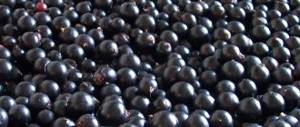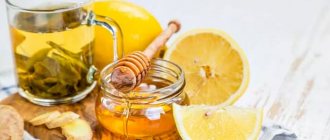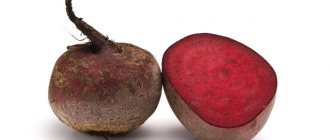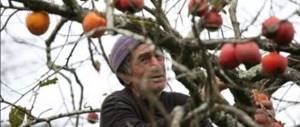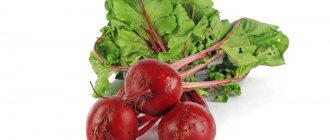When edema occurs due to fluid retention in the body, pumpkin helps well - as a diuretic of plant origin that removes water from tissues. It is a natural diuretic that allows you to get rid of swelling of various origins without disturbing the mineral balance, which happens when taking diuretic medications. Pumpkin fruits have an anti-inflammatory and diuretic effect, restoring the normal functioning of the kidneys and urinary tract. Pumpkin can be consumed during pregnancy accompanied by edema, as it is harmless to the baby.
Composition of pumpkin
Pumpkin pulp accumulates a unique vitamin and mineral complex. The vegetable contains a lot of vitamin PP, retinol, ascorbic acid, pyridoxine, folic acid, riboflavin, vitamin B5, thiamine, and tocopherol. Not without the participation of vitamin K and beta-carotene.
Pumpkin accumulates valuable mineral compounds in its composition. These include phosphorus, fluorine, potassium, chlorine, calcium, iron, magnesium, iodine and sodium.
Pumpkin is considered a dietary vegetable. It contains dietary fiber, pectin, organic acids, ash, a lot of water, Omega fatty acids. Calorie content of a 100 g serving. is only 23 Kcal.
Pumpkin seeds contain a lot of essential oils, and the pulp boasts such rare substances as phytin and carnitine (rare vitamin T).
benefits and harms of carrots
Is pumpkin good for those who want to lose weight?
Raw pumpkin is an excellent product for weight loss as it is low in calories. 100 g of pulp contains only 22 kcal. At the same time, the vegetable gives a feeling of fullness for a long time due to its high dietary fiber content.
Pumpkin helps you lose weight for the following reasons:
- removes toxins and excess fat consumed from food from the body;
- speeds up metabolism;
- prevents sudden surges in hunger due to the presence of chromium.
It is better to eat the product in the morning or in the evening for dinner. For example, add to salads, cottage cheese, or use as a component of fruit and vegetable smoothies. Boiled, stewed, baked (without sugar) and steamed pumpkin are also suitable for the diet. But it’s better to avoid fried vegetables and pumpkin seeds for a while - they have a high calorie content.
Benefits of pumpkin
- Frequent consumption of vegetables prevents obesity and helps to lose excess weight. It's all about the composition of the pumpkin; more than 88% is water. As you know, the human body needs it for the full functioning of all organs and systems. Losing weight with pumpkin is gentle, without stress on the nervous system and sudden breakdowns.
- Of particular value is observed for the entire digestive system. Pumpkin consumed 2 hours before a meal will contribute to better digestibility of food in the future. Valuable substances from the vegetable are quickly absorbed into the walls of the esophagus and distributed throughout the body.
- Pumpkin is the number one vegetable for fighting atherosclerosis and blockage of blood channels. The pulp and seeds of the fruit improve blood composition, thicken the walls of blood vessels, prevent thrombophlebitis and varicose veins.
- The vegetable is very popular for its ability to expel bile and facilitate the functioning of the liver. Pumpkin puree should be eaten by men and women who have addictions (fatty and heavy foods, smoking, alcohol, etc.).
- Due to its diuretic properties, the vegetable is used to reduce blood and intracranial pressure. Pumpkin pulp with sugar relieves headaches, and boiled vegetables without sweeteners reduce blood pressure.
- Pumpkin is indicated for use in cases of cholecystitis, pancreatitis, and gastritis. Also, the vegetable will bring undeniable benefits to the entire body, because vitamins A and E in its composition are natural antioxidants. They prolong youth and remove salts, radionuclides, and toxins.
- You can make face masks from pumpkin pulp, which perfectly cope with skin imperfections. Pumpkin whitens spots and freckles, saturates the epidermis with moisture, removes fine wrinkles and acne. Pumpkin masks are especially popular for ladies 40+.
- Thanks to the accumulation of B vitamins, pumpkin is considered a real antidepressant. Eating it systematically improves sleep, reduces susceptibility to stress, relieves anxiety and excessive irritability. Juice from vegetable pulp has the same effect.
- The vegetable is used for quick recovery after illness or serious surgery. Pumpkin is effective for respiratory diseases because it removes mucus and has an anti-inflammatory effect.
- Due to the high concentration of iron and copper, anemia is treated with pumpkin. The vegetable improves blood composition and replenishes iron deficiency. It is useful for pregnant women and girls to eat pumpkin during the menstrual cycle to increase hemoglobin.
- Beta-carotene, present in a decent amount, improves vision and prevents various diseases associated with the eyes. Pumpkin is needed to naturally strengthen muscles, lubricate the eye socket, and prevent cataracts and glaucoma.
- Pumpkin is needed to generally strengthen the immune system. It should be eaten in any form during the spread of seasonal colds. The vegetable is recommended for people who have a low immune system from birth and often get sick.
- Not without the positive impact of pumpkin seeds on men's health. They prevent prostate adenoma, prevent prostatitis, increase potency and promote increased sperm production.
Cooking methods
Pumpkin is rarely eaten raw. Mostly it is grated and added to vitamin salads. Cooking, as mentioned above, leads to the loss of a significant amount of nutrients. Fortunately, there are cooking methods that allow you to preserve the maximum of vitamins, macro- and microelements in the product.
For a couple
The most correct way of cooking. Due to the relatively low temperatures, B vitamins are not destroyed and minerals do not pass into the decoction.
How to cook steamed pumpkin? You need to wash and peel the vegetable, cut the pulp into medium-sized cubes, place in a double boiler and sprinkle with salt. Cook for 20 minutes. Serve with butter or sour cream and herbs.
Baking
When baked in the oven, the pumpkin quickly becomes covered with a crispy crust, which protects the vitamins from destruction. The vegetable acquires a rich sweet taste.
To prepare the baked pumpkin, cut the flesh into medium-sized pieces and place on a baking sheet greased with vegetable oil. Sprinkle with a little sugar or drizzle with honey. Place in the oven, preheated to 180 degrees. Bake for 10–15 minutes. Before serving, sprinkle the dish with Provençal or Italian herbs.
Cream soup
In this case, the liquid obtained when cooking the vegetable is not drained anywhere, which means you consume most of the vitamins and minerals. To prepare cream soup you need the following ingredients:
- pumpkin pulp – 0.5 kg;
- cream or full-fat milk – 200 ml;
- carrot – 1 piece;
- potatoes - 3 pieces;
- onion - 1 piece;
- spices and salt.
Chop the carrots and onions, fry in vegetable oil until golden brown. Cut the pumpkin and potatoes into small slices, place in a saucepan, add water (so that the liquid barely covers the vegetables). Boil until softened. Pour in the cream, add carrots and onions, salt and seasonings. Blend the mixture in a blender for 2 minutes. When serving, garnish the cream soup with pumpkin seeds and herbs.
Benefits of pumpkin for the liver
- Traditional healers use pumpkin to restore the structure of the liver, since the vegetable enhances the formation of new cells in the internal organ. Such a positive effect becomes possible because the composition contains pectins, iron, magnesium, calcium, and carotenoids.
- All positive compounds prevent such terrible diseases as hepatitis, cirrhosis, helminthiasis from developing and destroying liver tissue. Due to the accumulation of mineral salts and pectin, pumpkin has a diuretic effect and removes cholesterol. This is beneficial not only for the liver, but also for the kidneys.
- If you have liver ailments, eat the vegetable boiled, baked or in any other form. A decoction of the stalks is also effective, which must be taken in small portions throughout the day.
- In addition to vegetables and decoction, pumpkin juice is allowed. You can prepare it in any way possible. This drink is taken 2-3 glasses every day for 1 month. However, it is worth considering contraindications and the body’s reaction to the composition.
benefits and harms of radishes
What is the diuretic effect of pumpkin?
The diuretic effect of the product is concentrated in its pulp due to the sufficient content of potassium, calcium and magnesium, as well as other organic elements, which can be excreted when taking pharmaceutical drugs with a similar diuretic effect. In addition to getting rid of edema, the body is replenished with useful micro- and macroelements, which contains natural medicine. Seeds, stems and cuttings provide a diuretic effect, on the basis of which decoctions can be prepared.
Pumpkin as a diuretic is recommended for swelling, which can be caused by ailments associated with the kidneys, heart, liver or problems with salt metabolism.
Benefits of pumpkin for the gastrointestinal tract
- As mentioned earlier, pumpkin has a positive effect on the entire digestive system. The vegetable accumulates dietary fiber and pectins, which enhance the absorption of food and prevent its fermentation in the esophagus.
- Pumpkin is good for those who suffer from constipation. It has a mild laxative effect, which improves bowel movements. The vegetable improves intestinal microflora and peristalsis.
- Official medicine has recognized pumpkin as a powerful remedy that relieves vomiting and nausea. This quality is valued by girls in the early stages of pregnancy and people who get motion sickness in transport.
- Pumpkin seeds are an excellent remedy for removing intestinal parasites and worms. They are usually given to children to avoid taking heavy anthelmintic drugs.
benefits and harms of red onions
How to choose a delicious pumpkin?
When choosing a product, pay attention to the peel. It should be smooth, without signs of rot, damage, cracks, or pimples. Bright orange varieties are more suitable for making soups, while yellow and pink varieties are more suitable for boiling, baking, stewing, adding to porridges and baked goods.
Thus, pumpkin is a healthy, dietary, tasty and easy to prepare product. Pumpkin seeds and pulp can easily replace pharmaceutical drugs for you, especially in terms of replenishing vitamin A and mineral deficiencies. But you should not overuse the autumn vegetable, so as not to encounter indigestion and hypervitaminosis.
Benefits of pumpkin for the heart and circulatory system
- The vegetable is used to free blood channels from harmful cholesterol, and at the same time - to prevent atherosclerosis, thrombophlebitis, and varicose veins.
- Pumpkin seed, pulp and oil improve the density and elasticity of vascular walls. All parts of the vegetable accelerate blood circulation and prevent the development of various heart pathologies.
- Pumpkin should be eaten by people who have recently suffered a heart attack, stroke, or have other difficulties of this nature.
- Potassium, which is concentrated in large quantities in pumpkin, is necessary for lowering blood pressure, combating swelling of the extremities, and normalizing heart rate.
What are the benefits of pumpkin peel for the kidneys?
Those who consume pumpkin peel are not at risk of developing stones or urolithiasis. It is the peel that is a preventative against almost all kidney diseases.
How to prepare an infusion of pumpkin peel for kidney treatment - thin strips of pumpkin skin are dried in the oven and placed in a dry container for storage. A spoonful of the prepared dry product is steamed with half a liter of boiling water, kept on low heat for about 45 minutes, then tightly closed for 12 hours. You need to prepare it every day, the product does not store well, but it is easy to boil the prepared peel every evening for 10 days, leave it overnight, and in the morning get an effective remedy for treating the kidneys. They drink for 10 days, rest from treatment for a week, and so on three times. During treatment, the urine may become a different color and cloudy, but this is temporary and it will gradually recover.
The article contains several recipes that will certainly help, but only after consulting a specialist and following a strict diet.
Benefits of pumpkin for diabetics
- Patients diagnosed with diabetes often deny themselves foods with a high glycemic index. Luckily, pumpkin is not one of them. On the contrary, it accumulates a minimum of saccharides, preventing glucose from rising.
- The vegetable contains many minerals and vitamins that alleviate the course of the disease. In the case of diabetes, pumpkin puree will help remove excess fluid and lower blood pressure, strengthen the walls of blood channels, eliminate cholesterol plaques and prevent obesity.
- The beneficial properties of pumpkin for diabetics are due to the fact that the vegetable promotes the release of its own insulin. Dependence on drugs is reduced. Pumpkin-based desserts are prepared that are in no way inferior to chocolates, but do not worsen the patient’s condition.
- Not only pumpkin pulp, but also seeds are allowed for consumption. They contain many essential oils that enhance saturation. The seeds also have a choleretic effect, which is highly valued by diabetics.
benefits and harms of melon for the health of the body
Pumpkin juice for women's and men's health
Since it contains substances with anti-inflammatory properties, it is recommended as part of complex therapy as a remedy for the treatment of inflammatory diseases. For example, a man who consumes it can more effectively treat inflammation of the prostate gland.
The diuretic effects of pumpkin have been known since ancient times, so its juice is recommended for pregnant women. Thanks to its mild diuretic effect, you can get rid of swelling. Regular consumption of the product in moderate quantities will have a beneficial effect on many body systems.
Benefits of pumpkin for pregnant women
- During pregnancy, expectant mothers carefully plan their diet. A woman's menu should be carefully balanced and healthy. It is important that the products provide maximum benefits for the body of the girl and the baby.
- Healthy foods will help ensure normal lactation and increase the quality and quantity of milk. Therefore, during pregnancy, pumpkin will come in handy in your new diet. The vegetable contains the necessary complex of vitamins, minerals and active substances.
- If you systematically eat a vegetable, it will rid the body of excess fluid. Pumpkin improves digestive activity and problems with the gastrointestinal tract disappear. You will no longer suffer from constipation and frequent bloating. In addition, the body's cells will be saturated with the necessary enzymes.
- Pumpkin is necessary for a pregnant girl also because the product prevents the development of anemia. As a result, the fetus will not suffer from hypoxia. For proper formation of bone tissue, the raw material contains phosphorus and calcium.
- During the period of gestation, pumpkin copes well with toxicosis. The only drawback for some girls may be the presence of carotene in the vegetable. In rare cases, people are allergic to this enzyme. It is better to avoid consuming pumpkin.
- After giving birth, it is recommended to include pumpkin in the menu 15 days later. The vegetable will help keep your weight at the proper level, as a result you will not gain extra pounds. This question remains especially relevant during the lactation period. The raw material is saturated with vitamin K, an enzyme necessary for bleeding. Experts insist on consuming pumpkin to improve health.
Which pumpkin is healthier: raw or processed?
The benefits of raw pumpkin are undeniable, so it is best to consume the fruit in this form. True, many still doubt whether the vegetable can be eaten raw. Nutritionists say that salads and raw vegetable purees are very beneficial for digestion, and they also help get rid of excess fat. After a festive feast, it is useful to eat a few pieces of raw vegetables - this will ease the work of the stomach. The main thing is that the pumpkin is completely ripe. Eating raw, unripe vegetables can harm the body.
Heat treatment reduces the amount of vitamins and microelements. However, even in this form it brings, albeit smaller, but noticeable benefits. Baked pumpkin removes toxins and reduces the load on the heart. It is especially good for young children and the elderly to eat processed pumpkin. The raw fruit is too hard for old people and hard on the stomach of babies. Therefore, for these categories of people, processed pumpkin is the best choice.
Benefits of pumpkin seeds
- Vegetable seeds prevent the development of parasites in the body, stimulate movement and the secretion of bile. As a result, normal digestion is established. The seeds have a laxative effect. The composition gently relieves constipation and efficiently cleanses the body of toxic compounds and heavy metals.
- Systematic intake of raw materials ensures stable functioning of the gastrointestinal tract. The seeds are effective for gaining weight in cases of severe exhaustion. The product is also recommended for diabetics; the raw material reduces blood glucose levels.
- Pumpkin seeds remove harmful cholesterol, increasing the activity of the circulatory system and brain. The presence of linoleic and folic acids has a positive effect on the elasticity of artery walls. Raw materials help to avoid hypertension and problems with the heart muscle.
- Thanks to the content of zinc and phosphorus, the activity of brain impulses increases. Regularly eating pumpkin seeds will soon improve your memory and increase your fatigue threshold. Raw materials should be eaten during increased mental stress. The rich composition cleanses blood vessels and increases blood flow. The risk of developing arthrosis is reduced to a minimum.
- Including pumpkin in your daily diet can improve the functioning of your cardiovascular and nervous systems. The seeds help cope with depression and nervousness. In China, since ancient times, raw materials have been used as an effective remedy for neurological pathologies.
- The seeds have a mild diuretic effect. As a result, kidney function improves. Pumpkin seeds are considered an excellent preventative against stones and sand in the internal organs. The product has a positive effect on inert tissue, preventing the development of osteoporosis.
- The seeds are used as an additional remedy for the treatment of cancer tumors. Cucurbitacins fight free radicals. The substance also effectively destroys worms. The seeds have a positive effect on the health of the patient with oncology, and the general condition of the patient improves.
Traditional medicine recipes based on pumpkin
The fruits have an antibacterial, anti-inflammatory effect, and help with various acute and chronic diseases.
For arthritis
To relieve inflammation, combine 500 ml of pumpkin oil with 2 tbsp. l. wormwood. Boil in a water bath for 1.5 hours. They insist for 2 days. After 48 hours, filter. Rub into sore spots 2 times a day for 14 days.
For insomnia
In a glass container mix 300 g of pumpkin pulp, 2 tbsp. l. honey, pour 2 liters of water. Leave for an hour. The mixture is taken 100 ml 2 hours before bedtime. The course of therapy lasts 14 days.
For the liver and gastrointestinal tract
Mix 200 ml pumpkin oil with 2 tbsp. l. yarrow, 1.5 tbsp. l. St. John's wort. Leave in a dark place for a week. Take 1 tsp. 30 minutes before meals for 2 weeks.
For problems with the oral cavity
A mixture of pumpkin and fir oils helps with bad breath and infectious diseases of the mucous membranes. Both ingredients take 1 tsp. 30 minutes before meals, wipe the oral cavity with a cotton swab.
For problems with the nervous system
Juice is squeezed out of 1 kg of pumpkin. For pathologies of the nervous system, take 100 ml 2 times a day 15 minutes before meals. Therapy lasts 2 months, the break between courses is 14 days.
Pumpkin damage
- Pumpkin is one of the products that have a minimum number of contraindications. The pulp should not be consumed raw in case of diabetes mellitus, low acidity in the stomach, ulcers, gastritis and pathologies of the duodenum.
- If you often experience intestinal colic, it is advisable to avoid eating pumpkin. Do not forget that vegetable seeds do not have the best effect on the condition of tooth enamel. Always rinse your mouth after eating raw materials.
The beneficial properties of pumpkin have been known since ancient times. To this day, the pulp, oil and seeds are used for therapeutic and prophylactic purposes. The main purpose of the vegetable is to increase immunity, improve the functioning of the heart and gastrointestinal tract, and restore the liver. Pumpkin has a positive effect on the health of all people, regardless of age and gender. But you need to consider the potential harm that can come from overeating.
benefits and harms of watermelon
What to cook with pumpkin
Both the pulp and leaves of pumpkin are used in cooking because they taste good. The leaves are used in salads and vinaigrettes, and are also added to green cabbage soup, borscht, and soups. Pumpkin can be fried, steamed, cooked with millet and rice, made into minced meat from a mixture of pulp, sour cream, rice, raisins, eggs, baked with cottage cheese. Salads made from hard pumpkin and apples, lemon zest, honey and fruit juice are good.
Salad: take 100 g of pumpkin and apples, chop finely or grate, add zest, a teaspoon of honey, a teaspoon of sour fruit juice or lemon juice, sprinkle with ground nuts. You can serve.
Cream soup: take 200 g of zucchini and potatoes, chop finely, add white crackers, salt, sugar to taste. Boil in a small amount of water. Rub through a colander, add oil and put on fire. Pour in 1 liter of milk and cook until done.
Pumpkin-apple jam: take 800 g of pumpkin and 1.2 kg of sour apples and simmer them in a frying pan, rub while hot, add 1 kg of granulated sugar, orange or lemon peels. When the jam leaves the bottom of the dish, pack it in sterilized jars and cover with plastic or screw caps.
Botanical description
Pumpkin is an annual plant whose stems creep along the ground. Lateral shoots extend from the main shoot. Bush species can be found among hybrids. The plant is characterized by large leaves on long petioles. Large yellow or orange flowers bloom in the axils of the leaves, which are either female or male. The latter predominantly dominate, flowering is abundant.
At the end of flowering, the ovary of fruits, which are called pumpkins, begins. The vegetable has different shapes - pear-shaped, round or oblong. Pumpkin can be green, gray or orange, it all depends on the specific variety. The color of the pulp is also different.
The weight of standard species often does not exceed 10 kg. However, there are hybrids that grow to enormous sizes - weighing 100 kg, with a diameter of 1 m.
Pumpkin is an annual plant with creeping stems. Side shoots extend from the main stem. Among the hybrid varieties there are bush varieties. The leaves are large, on long stalks. Large yellow or orange single flowers bloom in the leaf axils. They are female and male. Flowering is abundant, male flowers predominate.
After flowering, fruits are set - multi-seeded false berries. They are called pumpkins. Pumpkins come in different shapes - round, oblong, pear-shaped. The color depends on the variety - there are gray, orange, and green varieties. The color of the pulp also varies.
Standard pumpkin varieties usually grow up to 10 kg. Some hybrid varieties are distinguished by their enormous size - reaching a weight of up to 100 kg and a meter in diameter.
Beneficial features
Pumpkin, like
The vegetable not only acts as a disease prevention, but also helps in the treatment of ailments. It is especially useful for certain diseases.
The benefits and harms of pumpkin for diabetics depend on the form in which the vegetable is consumed. The glycemic index of raw pulp is only 25 units. The benefits of pumpkin for diabetics in this case will be expressed in the fact that the vegetable will lower sugar levels and help the liver function.
But boiled and baked vegetables are prohibited for diabetics. Their glycemic indices are too high, and consuming the product will only be harmful to your health.
For gout
This healthy vegetable contains a lot of water, fiber and pectin, so it plays an important role in water-salt metabolism. For gout, the vegetable will help normalize uric acid levels, remove toxins and prevent the deposition of salts in the joints. The product can be used daily - its properties will not cause any harm.
For gastritis and ulcers
The vegetable is highly digestible; if consumed raw, boiled or baked, there will be no harm to an irritated stomach. On the contrary, the product will promote healing of mucous membranes, reduce pain and help cope with nausea.
However, the health benefits and harms of pumpkin for gastritis depend on the acidity of the stomach. If the production of gastric juice is reduced, there will be little benefit - the vegetable will not be able to speed up digestion.
The vegetable is great for cleansing the liver of toxins. The beneficial substances present in it promote the renewal of liver cells, prevent hepatitis and cirrhosis, and promote good bile secretion.
You can eat the vegetable for liver ailments every day, as part of salads and main courses. There are also vegetable-based recipes designed specifically for cleansing this organ.
For pancreatitis
As a rule, the product does not cause harm in case of inflammation of the pancreas - you can introduce the vegetable into the diet 3 days after the pain subsides. However, the pulp must be boiled before use.
The benefits of pumpkin for the pancreas depend on the volume - you can eat only 300 g of the product per day, dividing the total amount into small portions. Pumpkin juice is contraindicated for pancreatitis; the concentration of active substances in it is too high.
The beneficial properties of the product are so great that they can help even with tuberculosis and cancer. A vegetable in a regular diet helps suppress the growth of tuberculosis bacillus, so the vegetable is good for both prevention and treatment of the disease.
As for the fight against cancer, the antioxidants in the vegetable slow down the growth of malignant cells. You can use any part of the product for therapy, not only the pulp, but also the juice or pumpkin oil.
Important! Cancer or tuberculosis cannot be treated with product-based products alone.
Eating vegetables must be combined with medications, then there will be health benefits.
The healing properties of pumpkin are used in many home recipes. The vegetable helps improve well-being for a variety of ailments.
Pumpkin for constipation
The benefits and harms of fresh pumpkin lie in its laxative effect. To eliminate constipation, just prepare the following dish: grate 100 g of vegetables, carrots and 2 apples, season them with a teaspoon of olive oil and eat them in the morning or evening.
Steamed pumpkin will be beneficial in treating constipation - it can be mixed with honey, the dish will also have a relaxing effect on the intestines. The benefits of stewed pumpkin will also come in handy - it will enhance peristalsis and help remove toxins.
To prevent constipation, you can consume the vegetable in any form - the fiber in the product will help improve intestinal functions.
Pumpkin for pressure
The following vegetable-based dish will help with hypertension:
- 200 g of grated pumpkin pulp are mixed with 50 g of steamed and chopped raisins;
- add 50 g of sprouted wheat grains, crushed in a blender;
- Add 50 g of honey to the ingredients and mix thoroughly.
The product should be taken for a month, 250 g for breakfast. The benefit of pumpkin on an empty stomach is that it will cleanse and strengthen blood vessels, thereby helping to reduce blood pressure.
To remove excess fluid from the body, you need to crush and mix 10 g of pumpkin fruit cuttings, 5 g of flowers, and 10 g of blackcurrant leaves. The raw materials are poured with water, boiled, and then cooked over low heat for another quarter of an hour.
The chilled drink is filtered and taken twice a day, several sips. The benefit of pumpkin broth is its diuretic properties - swelling goes away very quickly.
To prevent the accumulation of cholesterol plaques and the occurrence of atherosclerosis, prepare the following remedy:
- 15 g of crushed pumpkin flowers and a handful of crushed hawthorn fruits are mixed together;
- the ingredients are poured into a small container and filled with vodka, and then removed to infuse for a week;
- when the product is ready, filter it and drink 20 drops twice a day, with a couple of sips of water.
Treatment should be continued for no longer than 10 days, otherwise the tincture may be harmful.
The benefits of pumpkin for the liver are manifested in the fact that the vegetable effectively removes toxins from the body. Usually pumpkin oil is used for cleansing - they drink a teaspoon of it for a month in the morning before breakfast. Then they take a break of the same duration and, if necessary, repeat the course.
Raw pumpkin benefits the liver in another popular recipe. The top of the fresh vegetable is carefully cut off, the seed cavities are removed and liquid honey is poured into the free space. After this, the cut top is placed on top like a lid, the edges are sealed with dough and the vegetable is placed in a dark, cool place for 1.5 weeks.
After this period, honey, which has absorbed all the valuable properties of the vegetable, is consumed three times a day, 20 g before meals. The course of treatment is continued for no more than 3 weeks.
The medicinal properties of pumpkin in folk medicine are also used externally. For burns, skin damage and dermatological ailments, it is recommended to lubricate the sore spots with pumpkin pulp pulp several times a day. The product promotes faster tissue restoration.

